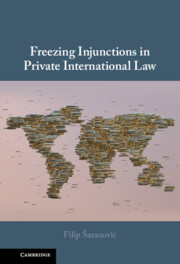Book contents
- Freezing Injunctions in Private International Law
- Freezing Injunctions in Private International Law
- Copyright page
- Contents
- Acknowledgements
- 1 Introduction
- 2 Historical Foundations of Freezing Injunctions
- 3 Theoretical Foundations of Freezing Injunctions
- 4 Theoretical Foundations of Jurisdiction in Private International Law
- 5 Application of Jurisdictional Theories
- 6 Reform Proposals
- 7 The Relationship between Freezing Injunctions and Other Interim Relief
- 8 Conclusions
- Index
8 - Conclusions
Published online by Cambridge University Press: 20 October 2022
- Freezing Injunctions in Private International Law
- Freezing Injunctions in Private International Law
- Copyright page
- Contents
- Acknowledgements
- 1 Introduction
- 2 Historical Foundations of Freezing Injunctions
- 3 Theoretical Foundations of Freezing Injunctions
- 4 Theoretical Foundations of Jurisdiction in Private International Law
- 5 Application of Jurisdictional Theories
- 6 Reform Proposals
- 7 The Relationship between Freezing Injunctions and Other Interim Relief
- 8 Conclusions
- Index
Summary
This chapter is divided into two sections. The first provides a summary of the conclusions relating to the substantive scope of freezing injunctions. It proposes a number of changes to the preconditions for obtaining a freezing injunction in order to improve certainty and create a level playing field in litigation. The need to establish a good arguable case on the merits is considered, taking into account some positive developments in this area. The case law on the real risk of dissipation of assets is the main focus of criticism. The second section of the chapter contains some thematic comments on the international scope of freezing injunctions and explains the need for a more restrictive approach in future cases.
Keywords
- Type
- Chapter
- Information
- Freezing Injunctions in Private International Law , pp. 242 - 254Publisher: Cambridge University PressPrint publication year: 2022

